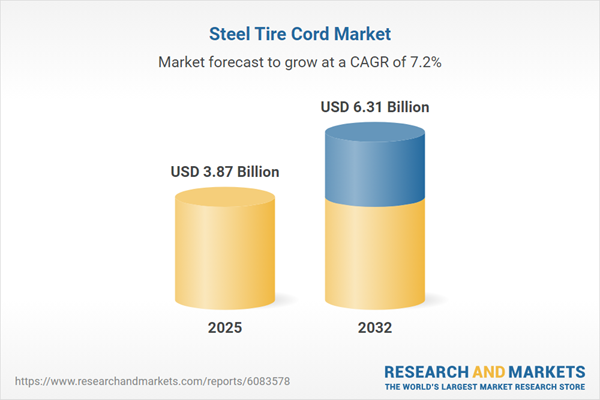Speak directly to the analyst to clarify any post sales queries you may have.
The steel tire cord market is positioned for robust growth as automotive manufacturers demand advanced reinforcement materials to optimize tire performance and respond to regulatory trends. Stakeholders must stay at the forefront of industry innovation and adapt agile procurement strategies to navigate shifting supply chains, especially amid evolving tariffs and sustainability mandates.
Market Snapshot: Steel Tire Cord Market Growth Outlook
The steel tire cord market grew from USD 3.63 billion in 2024 to USD 3.87 billion in 2025 and is forecast to sustain a CAGR of 7.15%, reaching USD 6.31 billion by 2032. Elevated by demand for high-performance passenger and commercial tires, the sector benefits from technological advancements in coating chemistries and precision manufacturing methods. Market momentum is further shaped by regulatory pressures for energy efficiency and regional development of automotive fleets across both mature and emerging economies.
Scope & Segmentation
This report provides an in-depth analysis of the steel tire cord market, examining critical segments and regional trends to support senior business decisions.
- Type: Brass coated, Copper coated, and Zinc coated steel tire cords cater to distinct performance requirements in durability, flexibility, and corrosion resistance.
- Manufacturing Process: Electroplating and hot-dipped processes offer varying advantages in coating precision versus cost-effectiveness, impacting quality and scalability.
- Application: Target segments include aircraft tires, commercial vehicle tires, industrial tires, passenger vehicle tires, and two-wheeler tires—each with specialized demands for fatigue resistance, load capacity, and operational environment.
- End Use Application: The analysis distinguishes between aftermarket and original equipment manufacturer needs, emphasizing supply chain diversity and tailored performance attributes.
- Geographies: Americas (United States, Canada, Mexico, Brazil, Argentina, Chile, Colombia, Peru), Europe, Middle East, & Africa (United Kingdom, Germany, France, Russia, Italy, Spain, Netherlands, Sweden, Poland, Switzerland, United Arab Emirates, Saudi Arabia, Qatar, Turkey, Israel, South Africa, Nigeria, Egypt, Kenya), and Asia-Pacific (China, India, Japan, Australia, South Korea, Indonesia, Thailand, Malaysia, Singapore, Taiwan).
- Key Companies: Includes global leaders such as Ansteel Group Corporation, Baosteel Group Corporation, Bridgestone Corporation, Continental AG, Dongkuk Steel Co., Ltd., Hankook Tire, Hyosung Corporation, Nippon Steel Corporation, Tata Steel Limited, and others.
Key Takeaways: Strategic Insights and Growth Drivers
- Technological innovations in alloy composition, nano-coatings, and precision electroplating are elevating performance, enabling lighter and longer-lasting tires for both electric and traditional vehicles.
- Collaboration between material suppliers and tire manufacturers is accelerating the development of custom steel cord solutions, supporting specialized applications and improving end-user satisfaction.
- Regional consumption trends reflect a dual focus: established markets pursue sustainability and premium performance, while Asia-Pacific regions prioritize efficient, high-volume output due to growing domestic production.
- Sustainability imperatives are driving investments in eco-friendly coatings and recycling initiatives to minimize lifecycle impacts.
- Stringent regulatory requirements worldwide are pushing industry participants to enhance quality control, safety margins, and compliance in the manufacturing pipeline.
- Competitive differentiation is emerging through digitalization, automation, and integrated supply chain strategies, reducing lead times and enhancing agility.
Tariff Impact: United States Tariffs from 2025
The implementation of new United States tariffs on steel tire cord imports starting in 2025 will significantly influence sourcing and cost structures. Companies are proactively engaging with regional suppliers, investing in local processing, and considering the redesign of reinforcement materials to adapt to these trade measures. These changes have broad implications, including reshaping warehousing, logistics, and distribution, and prompting further automation to protect profitability.
Methodology & Data Sources
Our research integrates primary interviews with industry executives and secondary reviews of technical publications, regulatory filings, and company financials. Data triangulation ensures consistency across qualitative insights and quantitative indicators, employing in-house analytical models and regional workshops to refine projections and validate conclusions.
Why This Report Matters
- Decision-makers gain clarity on market segmentation, enabling precise targeting of growth opportunities and risk mitigation strategies.
- The analysis equips stakeholders to respond effectively to regulatory and technological changes, streamlining procurement and R&D investments.
- Actionable insights support long-term planning for product differentiation, sustainability, and supply chain resilience.
Conclusion
The steel tire cord market is defined by innovation, regulation, and evolving regional dynamics. Leaders who align operational strategies with market demands and proactively address new trade realities will be positioned for sustainable growth.
Table of Contents
3. Executive Summary
4. Market Overview
7. Cumulative Impact of Artificial Intelligence 2025
List of Figures
Samples

LOADING...
Companies Mentioned
The key companies profiled in this Steel Tire Cord market report include:- Ansteel Group Corporation
- Baosteel Group Corporation
- Bridgestone Corporation
- Continental AG
- Dongkuk Steel Co., Ltd.
- Hankook Tire
- HBT RUBBER INDUSTRIAL CO.,LTD
- Henan Hengxing Science & Technology Co., Ltd
- Hendrickson USA, L.L.C.
- HL group ltd
- Hyosung Corporation
- Hyundai Steel Company., Ltd.
- JFE Steel Corporation
- Kolon Industries Inc.
- N.V. Bekaert S.A.
- Newcore Global Pvt. Ltd
- Nippon Steel Corporation
- POSCO Holdings Inc.
- Shougang Century Holdings Limited
- Sumitomo Electric Industries, Ltd.
- Tata Steel Limited
- Tokusen Kogyo Co., Ltd
- Tokyo Rope Mfg. Co., Ltd:
- Voestalpine AG
- YUSHENG ENTERPRISE LIMITED
Table Information
| Report Attribute | Details |
|---|---|
| No. of Pages | 186 |
| Published | October 2025 |
| Forecast Period | 2025 - 2032 |
| Estimated Market Value ( USD | $ 3.87 Billion |
| Forecasted Market Value ( USD | $ 6.31 Billion |
| Compound Annual Growth Rate | 7.1% |
| Regions Covered | Global |
| No. of Companies Mentioned | 26 |








